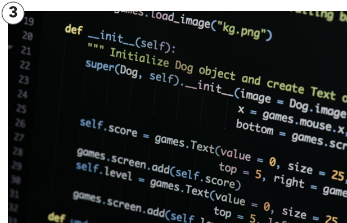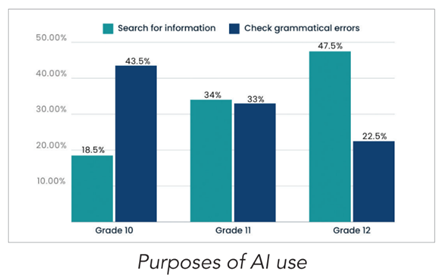Giải SGK, SBT Unit 7. Artificial intelligence English Discovery
Giải SGK, SBT Unit 7 English Discovery
|
VOCABULARY FOCUS A (TẬP TRUNG TỪ VỰNG) AI artificial intelligence (trí tuệ nhân tạo) deep learning (học kĩ càng) machine learning (học máy) neural networks (mạng lưới thần kinh) reinforcement learning (học tăng cường) |
5. Use the words in VOCABULARY FOCUS B to say which Al technique or application you like most and why.
(Sử dụng các từ trong TẬP TRUNG TỪ VỰNG B để nói kỹ thuật hoặc ứng dụng Al nào bạn thích nhất và tại sao.)
|
VOCABULARY FOCUS B Transformative: • Verbs: revolutionize, change, transform • Nouns: technology, innovation, progress Autonomous: • Verbs: operate, function, control • Nouns: system, robot, vehicle, device Innovative: • Verbs: create, invent, develop • Nouns: software, algorithm, tool Adaptive: • Verbs: modify, evolve, learn • Nouns: system, algorithm, model Predictive: • Verbs: forecast, predict, estimate • Nouns: model, algorithm, analysis Creative: • Verbs: generate, create, design, invent • Nouns: software, tool, system, application Efficient: • Verbs: optimize, improve, enhance • Nouns: system, tool, technique |
|
TẬP TRUNG TỪ VỰNG B Biến đổi: • Động từ: cách mạng hóa, thay đổi, biến đổi • Danh từ: công nghệ, đổi mới, tiến bộ Tự chủ: • Động từ: vận hành, chức năng, điều khiển • Danh từ: hệ thống, robot, phương tiện, thiết bị Đổi mới: • Động từ: sáng tạo, phát minh, phát triển • Danh từ: phần mềm, thuật toán, công cụ Thích ứng: • Động từ: sửa đổi, phát triển, học hỏi • Danh từ: hệ thống, thuật toán, mô hình Dự đoán: • Động từ: dự báo, đoán trước, ước lượng • Danh từ: mô hình, thuật toán, phân tích Sáng tạo: • Động từ: tạo ra, sáng tạo, thiết kế, phát minh • Danh từ: phần mềm, công cụ, hệ thống, ứng dụng Có hiệu quả: • Động từ: tối ưu hóa, cải thiện, nâng cao • Danh từ: hệ thống, công cụ, kỹ thuật |
An Al application I like most is __________ on my phone. It is a transformative technology that changes my life.
An Al technology I like most is ________ efficient tool that can enhance my memory. It is an efficient tool that can enhance my memory.
The application I'm most interested in is ______________.
It can forecast things that happen in the future. It is predictive.
3. Read the GRAMMAR FOCUS and find complex, compound and simple sentences in the text.
|
GRAMMAR FOCUS Simple sentences • Contains a subject and predicate Chatbots can answer the phone 24/7. • It's also called an independent clause because it's a complete sentence. Compound sentences • Contains two (or more) independent clauses • The clauses are linked by a coordinating conjunction. Chatbots can answer the phone 24/7, and they can also record customer data. • Coordinating conjunctions include: for, and, nor, but, or, yet, so, therefore, however, because, although Complex sentences • Contains an independent and a dependent clause. • The dependent clause begins with a subordinating conjunction. After a chatbots finishes a call, it records then adds the customer data to the database. • Subordinating conjunctions include: after, before, because, since, if, while, so, that, wherever, etc. |
|
NGỮ PHÁP TRỌNG TÂM Những câu đơn giản • Chứa chủ ngữ và vị ngữ Chatbots có thể trả lời điện thoại 24/7. • Nó còn được gọi là mệnh đề độc lập vì nó là một câu hoàn chỉnh. Câu ghép • Chứa hai (hoặc nhiều) mệnh đề độc lập • Các mệnh đề được liên kết với nhau bằng liên từ phối hợp. Chatbots có thể trả lời điện thoại 24/7 và chúng cũng có thể ghi lại dữ liệu khách hàng. • Liên từ phối hợp bao gồm: for, and, nor, but, or, yet, so, do đó, tuy nhiên, bởi vì, mặc dù Câu phức tạp • Chứa mệnh đề độc lập và mệnh đề phụ thuộc. • Mệnh đề phụ thuộc bắt đầu bằng liên từ phụ thuộc. Sau khi chatbot kết thúc cuộc gọi, nó sẽ ghi lại rồi thêm dữ liệu khách hàng vào cơ sở dữ liệu. • Liên từ phụ thuộc bao gồm: sau, trước, bởi vì, vì, nếu, trong khi, so, đó, ở đâu, v.v. |
4. Read the sentences and tick (✔) the correct type for each sentence.
(Đọc các câu và đánh dấu ( ✔) vào loại đúng cho mỗi câu.)
|
|
Simple |
Compound |
Complex |
|
1. Because they respond to students’ questions 24/7, online learning sites now use chatbots. (Vì trả lời câu hỏi của học sinh 24/7 nên các trang học trực tuyến hiện nay đều sử dụng chatbot.) |
|
|
|
|
2. Digital marketers love chatbots, and they are using chatbots more often. (Các nhà tiếp thị kỹ thuật số yêu thích chatbot và họ đang sử dụng chatbot thường xuyên hơn.) |
|
|
|
|
3. Chatbots are useful in education because they can analyse students' mistakes. (Chatbot rất hữu ích trong giáo dục vì chúng có thể phân tích lỗi của học sinh.) |
|
|
|
|
4. Digital marketers use chatbots to create more personalized experiences for customers. (Các nhà tiếp thị kỹ thuật số sử dụng chatbot để tạo ra nhiều trải nghiệm cá nhân hóa hơn cho khách hàng.) |
|
|
|
|
5. Chatbots can replace some human customer service agents, so they save companies a lot of money. (Chatbots có thể thay thế một số nhân viên dịch vụ khách hàng của con người, vì vậy chúng giúp các công ty tiết kiệm rất nhiều tiền.) |
|
|
|
|
6. I think chatbots will someday replace many different jobs. (Tôi nghĩ một ngày nào đó chatbot sẽ thay thế nhiều công việc khác nhau.) |
|
|
|
|
VOCABUALRY FOCUS (TẬP TRUNG TỪ VỰNG) ΑΙ impressive (ấn tượng) potential (tiềm năng) toxic (độc hại) tutor (hướng dẫn) fine-tune (tinh chỉnh) |
3. Underline in the text above examples of the two structures below.
(Gạch chân trong đoạn văn trên ví dụ về hai cấu trúc dưới đây.)
|
LANGUAGE FOCUS Causative verbs are used to indicate that someone or something causes another person to do something or causes something to happen. ⚫ have / get + object + past participle ⚫ get + someone / something+to+ verb (infinitive) |
|
NGÔN NGỮ TRỌNG TÂM Động từ nguyên nhân được sử dụng để chỉ ra rằng ai đó hoặc điều gì đó khiến người khác làm điều gì đó hoặc khiến điều gì đó xảy ra. ⚫ có / get + đối tượng + phân từ quá khứ ⚫ get + ai đó / something+to+ động từ (nguyên mẫu) |
4. Read the LANGUAGE FOCUS and find examples from the writing in Exercise 2.
(Đọc TẬP TRUNG NGÔN NGỮ và tìm ví dụ từ bài viết ở Bài tập 2.)
|
LANGUAGE FOCUS Here are some useful expressions of comparison and contrast in a static chart: Comparing data sets: "X is greater than/ less than Y” “X is higher / lower than Y” "X is more / less than Y "X is larger/smaller than Y" "More X+ verb +than+y" "X is longer/shorter than Y” "X is the same as Y" Highlighting differences: “X shows a significant difference from Y" "X is notably different from Y "Between two groups, there is/was a difference in the..." "The greatest difference is found in ..." Comparing proportions: "A similar number of X + verb + than Y” "X is a larger/smaller proportion of the total than Y” "X accounts for a higher/lower percentage of the total than Y" "X is a higher / lower proportion compared to Y” "X is a smaller / larger percentage of the total than Y" |
|
NGÔN NGỮ TRỌNG TÂM Dưới đây là một số biểu thức so sánh và tương phản hữu ích trong biểu đồ tĩnh: So sánh các tập dữ liệu: "X lớn hơn/nhỏ hơn Y" “X cao hơn/thấp hơn Y” “X lớn hơn/nhỏ hơn Y "X lớn hơn/nhỏ hơn Y" "Thêm động từ X+ +than+y" “X dài hơn/ngắn hơn Y” "X giống với Y" Làm nổi bật sự khác biệt: “X cho thấy sự khác biệt đáng kể so với Y” "X khác biệt đáng kể so với Y "Giữa hai nhóm, có/có sự khác biệt về..." "Sự khác biệt lớn nhất được tìm thấy ở ..." So sánh tỉ lệ: “Một số tương tự của X + động từ + hơn Y” "X là tỷ lệ lớn hơn/nhỏ hơn trong tổng số so với Y" "X chiếm tỷ lệ phần trăm cao hơn/thấp hơn trong tổng số so với Y" “X là tỷ lệ cao hơn/thấp hơn so với Y” "X là tỷ lệ phần trăm nhỏ hơn/lớn hơn trong tổng số so với Y" |
3. Write 1-4 in the gaps (___) in the text.
(Viết 1-4 vào chỗ trống (___) trong đoạn văn.)
|
SPEAKING FOCUS Making predictions: We can use these techniques to make predictions. 1. Using future tenses There will be big changes in the future. 2. Using modal verbs There might be fewer jobs. 3. Using adverbials Obviously, Al will impact how we work in the future. 4. Using other expressions I'm not sure what might happen, but one possibility is It's hard to predict the future, but I suppose it/we might... It's quite likely that… In the long run, I think… In years to come, I believe... |
|
TẬP TRUNG NÓI Đưa ra dự đoán: Chúng ta có thể sử dụng những kỹ thuật này để đưa ra dự đoán. 1. Sử dụng thì tương lai Sẽ có những thay đổi lớn trong tương lai. 2. Sử dụng động từ khiếm khuyết Có thể có ít việc làm hơn. 3. Sử dụng trạng từ Rõ ràng, Al sẽ tác động đến cách chúng ta làm việc trong tương lai. 4. Sử dụng các cách diễn đạt khác Tôi không chắc điều gì có thể xảy ra, nhưng có một khả năng là Thật khó để đoán trước được tương lai, nhưng tôi cho rằng/chúng ta có thể... Rất có thể là… Về lâu dài, tôi nghĩ… Trong những năm tới, tôi tin... |
VOCABULARY
1. Write the correct phrases next to their definitions below.
(Viết các cụm từ đúng bên cạnh định nghĩa của chúng dưới đây.)
|
Definitions |
Words |
|
1. an attempt to copy human intelligence and behavior patterns |
|
|
2. an Al technique that teaches computers to learn from experiences and data without using rules |
|
|
3. study of how to program computers to process and analyze large amounts of natural language |
|
|
4. a machine learning technique that teaches computers to learn from examples |
|
|
5. a method of teaching computers to process data in a way similar to how our brain works |
|
|
6. a machine learning method based on rewarding desired behaviors |
|
2. Use the words/phrases below to fill in the blanks. There are some extra words.
|
adaptive benefit customized dealing with (thích ứng) (lợi ích) (tùy chỉnh) (ứng phó) inspire potential predictive risks (cảm hứng) (tiềm ẩn) (dự đoán) (rủi ro) resource translate (tài nguyên) (dịch) |
The advantages of (1) ________ computer technology far outweigh the (2) ___________. First, online learning programs can be (3) __________ to meet individual student's needs. The online programs can be a terrific (4) ______ when teachers or tutors are unavailable. The (5) _____________ it possesses in (6) _________ every students will (7) ______ and teachers alike.
1. Match the phrases 1-5 to their definitions a-e.
(Nối các cụm từ 1 – 5 với định nghĩa của chúng.)
|
1. Reinforcement learning 2. Artificial Intelligence 3. Neural networks 4. Deep learning 5. Machine learning |
a. is a method of teaching computers that is similar to the function of human brains. b. is a technique which teaches computers to learn from data. c. is a method of machine learning that is based on rewarding desired behaviors. d. duplicate the intelligence and behavior patterns of humans. e. is a machine learning technique that allows computers to learn from only one type of data-experience. |
2. Complete the table using the words in the box. Some words might be used twice.
(Hoàn thảnh bảng sau dùng các từ trong hộp. Có vài từ có thể dùng hai lần.)
|
yet |
so that |
whenever |
wherever |
|
and |
before |
because |
therefore |
|
so |
for |
after |
even though |
|
Coordinating conjunctions |
Subordinating conjunctions |
3. Complete the table. Write only ONE word for each blank.
(Hoàn thành bảng sau. Chỉ viết MỘT từ vào chỗ trống.)
|
Advantages |
Disadvantages |
|
- (1) _____ the process of information seeking - enhance (2) _____ autonomy - rich source of ideas - (3) _____long texts such as essays |
- occasional inaccurate information which can (4) _____ students' learning experience - plagiarism and cheating are (5) _____ |
1. Complete the gaps using the words in the box.
(Hoàn thành các chỗ trống dùng các từ trong hộp.)
|
impressive |
potential |
toxic |
|
tutor |
fine-tune |
code |
1. Writing programs for technological devices means working with a massive number of lines of _____.
2. The engineers from Samsung had to work for years to _____ the series of mobile phone products called Samsung Galaxy.
3. An AI-based application is as supportive as a personal _____ thanks to the great amount of useful guidance it offers.
4. Biased and _____ language that contains false information can be generated from AI.
5. A _____ threat emerging from exposing too much to technology is the deterioration of physical health.
6. The rapid advancement of technology with the invention of AI, is _____.
1. Match the phrasal verbs 1 – 5 with their meanings a - e.
(Nối các động từ 1 – 5 với các ý nghĩa của chúng a – e.)
|
1. get around to 2. look up to 3. come up with 4. live up to 5. put up with |
a. to accept or continue to accept an unpleasant situation or experience, or someone who behaves unpleasantly b. to suggest or think of an idea or plan c. to admire and respect someone d. to do something that you have intended to do for a long time e. to achieve what is expected, especially high standards |
1. Write the kinds of learning relevant to their features.
(Viết kiểu học tập phù hợp với chức năng của chúng.)
|
Feature |
Kinds of learning |
|
Learning from only one type of data-experience |
|
|
Learning from data |
|
|
Based on rewarding |












